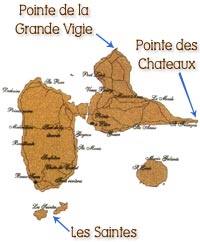 |
|
|
Grande-Terre. After figuring out where to buy tickets for a next-day trip, we walked around the large city square, Place de la Victoire. It's a pretty, open space, bordered by La Darse on one end and neat colonial buildings and restaurants(including McDonalds) on the others. The information center is in an especially nice building. We left the city and continued east, to explore Grande-Terre as much as possible on this day. On the southern coast we travelled through Sainte-Anne, to Saint-Francois, and beyond, out the narrow eastern finger to its tip, Pointe des Chateaux. It was quite hot and humid, and extremely windy as we walked to the beach. A beautiful landscape, so perfect in sky and water, it almost looked like a scenic backdrop. A few vendors were selling crafty things. We got some sun shapes made of the different sands from around the island. We continued to loosely circumnavigate Grande-Terre. The city of Le Moule, had my pulse racing — it was one of those places that hit me as special right away. I love it when that happens. An old plaza with a stately, columned building, and many other old buildings with character gave off a good aura. And the shore had wild waves crashing about. The countryside was full of sugar cane fields and old sugar mill towers. We saw an ox pulling a cart — very exciting. Along the roadside there was a large tree with hundreds of egrets in it. We passed through other interesting coastal towns — Petit-Canal, Port-Louis, Anse-Bertrand — on our way to Guadeloupe's northernmost point, Pointe de la Grande Vigie. That was another spectacular setting, but different from Pointe des Chateaux. No beach there — we were high (260 feet)above sea level on steep, dramatic cliffs that outlined the northern coast. There were some trails with signs that pointed to distant islands like Montserrat and Antigua, though we couldn't see them. The next morning was an early-riser: we drove back to Pointe-à-Pitre before rush hour to catch our boat. We were there with time to kill so we walked around La Darse enjoying the morning light; a nice dog showed us around. Les Saintes. We were going to Terre-de-Haut, the main island (of eight) in the archipelago. Only one other, Terre-de-Bas, is inhabited. The semicircular harbor is bookended by mountains, so you are embraced upon arrival. It's a spectacular setting. I have to use the overused word "quaint" to describe the port area, there were colorful shops, restaurants and Creole houses. We immediately headed east, to make our way to Fort Napoleon. The fort was built by the French in 1867, but never used as such because the British stopped their aggressions after signing the Treaty of Paris in 1815. Hmm ... did news travel that slowly? Anyway, I was glad for the fort ... it's atop a large hill which we spiralled up on foot. The views going up were gorgeous, down at the harbor and other islands and across to the mountains of Basse-Terre. (panoramics here)
As we were leaving through the only gate, I heard my name called. Now, that made me stop short, confused. Who knew me here? Turns out my credit card and a 20-euro bill fell out of my backpack somewhere in the fort. And the women at the entrance were calling my name as people left until someone responded. Luckily Peter had my passport, so we could prove who I was, and they gave me the card. Whew — I hadn't even known it was missing, lucky me that someone was responsible and honest.
There's a small airstrip nearby, and neighborhoods with pretty homes and yards. We got back to Le Bourg, the main town, got some sustenance and did some shopping. It's a beautiful little village, full of color, interesting architecture, cobblestoned streets. There's a pretty stone church, nice courtyards — all so welcoming. We hung out and enjoyed the atmosphere until it was time for the return trip. Visiting Les Saintes was the highlight of the trip; don't miss it if you go. But there was still more to see and do back on the "mainland" ...
|
Photo pages:
On the Map
|
|
Guadeloupe
Main Page |
|
